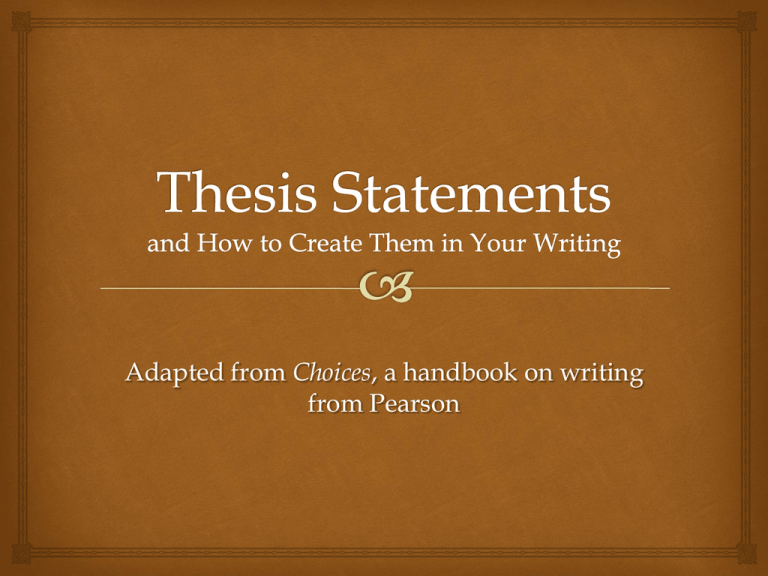Thesis Statements
advertisement

Adapted from Choices, a handbook on writing from Pearson What is a thesis? A thesis is a complete sentence that demonstrates the “take away value” of your writing. It answers the question readers may be asking themselves: “So what?” Answers to these questions will lead you to the thesis or the main idea. Why will your readers care about your topic and your writing? What do you want your readers to take away from your writing? Why are you the best person to write about this topic in this way at this time? An effective thesis statement demands proof or demonstration. It is never a question, but it is often the answer to a question. A thesis statement . . . Uses specific, objective language Identifies the topic States your purpose, intention, or attitude toward the topic May suggest the arrangement or organization of the ideas to come Writers commonly revise their thesis statements. Don’t expect to think of a perfect thesis at the beginning. Plan to create a “working thesis” that you can use as you revise your sloppy copy into a draft. A working thesis need not be elegant or formal; it just needs to get you started. Some examples of poor thesis statements and revision: My instructor has an attendance policy. My instructor should change her attendance policy because it is unreasonable, inflexible, and unfair. Some children show violent behavior. Conflict-resolution courses should be taught to help prevent violence in America’s schools. Social networking sites such as Facebook can cause problems. College students should be careful of what they put on their Facebook pages because prospective employees routinely check them. Some strategies that can help you create a working thesis: Reword the topic question into a statement. Use “I” statements. Writing from your own viewpoint can help you figure out what you are trying to say. If first person is not appropriate for your audience, you can edit the wording later. More Strategies Choose a sentence from the last paragraph of your sloppy copy. Writers often figure out what they want to say as they are writing. Choose any sentence from your sloppy copy that meets the criteria. You just need something to get you started; you can change your working thesis as you write. Use a fill-in-the-blank sentence. “Although many people think ____, in reality, ____ because ____.” “_____ is the most significant _____ because _____.” “______ illuminates the role of ______ in people’s lives by showing us how _______, _____, and _____.” More fill-in-the-blanks “Although many reasons have been suggested for _____, they all boil down to _____.” “_____ is true for these reasons: _____, _____, _____, and _____. “X has argued that _____, but Y’s position is stronger because _____.” “The more important effects of _____ went beyond those of _____.” Remember that a thesis statement helps to shape the rest of your paper. Different thesis statements lead to different papers. If you find that your paper does not match your working thesis, you will need to change one to fit the other. Any Questions? Note: This PowerPoint was first developed by Professor David Carithers, Department of English and MFL, and has helped numerous students with shaping thesis statements. Example thesis statements were taken from Patterns for College Writing by Laurie G. Kirszner and Stephen R. Mandell. In September of 2014, Riley Rich, student assistant in the Writing Center, redesigned this PowerPoint and added example thesis statements.








